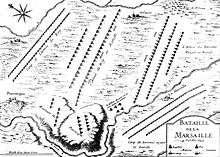Battle of Marsaglia
| Battle of Marsaglia | |||||||||
|---|---|---|---|---|---|---|---|---|---|
| Part of the Nine Years' War | |||||||||
 Catinat at Marsaglia, 4 octobre 1693 | |||||||||
| |||||||||
| Belligerents | |||||||||
|
|
| ||||||||
| Commanders and leaders | |||||||||
| Nicolas Catinat |
| ||||||||
| Strength | |||||||||
| 35,000 | 30,000 | ||||||||
| Casualties and losses | |||||||||
| 1,800 dead or wounded | 10,000 dead, wounded, or captured | ||||||||

The Battle of Marsaglia was a battle in the Nine Years' War, fought in Italy on 4 October 1693, between the French army of Marshal Nicolas Catinat and the army of the Grand Alliance under Duke Victor Amadeus II of Savoy.
Catinat, advancing from Fenestrelle and Susa to the relief Pinerolo, defended by the count of Tessé and which the duke of Savoy was besieging, took up a position in formal order of battle north of the village of Marsaglia, near Orbassano.
Here, on 4 October, the duke of Savoy attacked him with his whole army, front to front. But the greatly superior regimental efficiency of the French, and Catinat's minute attention to details in arraying them, gave the new marshal a victory that was a not unworthy pendant to Neerwinden.
The Piedmontese and their allies lost c. 10,000 killed, wounded and prisoners, as against Catinat's 1,800.
Marsaglia is, if not the first, at any rate, one of the first, instances of a bayonet charge by a long deployed line of infantry. Hussars figured here for the first time in western Europe. A regiment of them had been raised in 1692 from deserters from the Austrian service.
Notes
- ↑ William Russell; William Jones (1857). pt.II. From the peace of Westphalia in 1648, to the peace of Paris, in 1763. Harper & Brothers. p. 277. Retrieved 24 April 2013.
- ↑ George Bruce Malleson (9 December 2010). Prince Eugene of Savoy. Cambridge University Press. p. 42. ISBN 978-1-108-02403-7. Retrieved 24 April 2013.
- ↑
- "...the standard of France was white, sprinkled with golden fleur de lis..." (Ripley & Dana 1879, p. 250).
- On the reverse of this plate it says: "Le pavillon royal était véritablement le drapeau national au dix-huitième siecle...Vue du chateau d'arrière d'un vaisseau de guerre de haut rang portant le pavillon royal (blanc, avec les armes de France)" (Vinkhuijzen collection 2011).
- "The oriflamme and the Chape de St Martin were succeeded at the end of the 16th century, when Henry III., the last of the house of Valois, came to the throne, by the white standard powdered with fleurs-de-lis. This in turn gave place to the famous tricolour"(Chisholm 1911, p. 460).
References
 Chisholm, Hugh, ed. (1911). "Flag". Encyclopædia Britannica. 10 (11th ed.). Cambridge University Press. pp. 454–463.
Chisholm, Hugh, ed. (1911). "Flag". Encyclopædia Britannica. 10 (11th ed.). Cambridge University Press. pp. 454–463. Ripley, George; Dana, Charles A., eds. (1879). "Flag". The American Cyclopædia. 8. p. 250.
Ripley, George; Dana, Charles A., eds. (1879). "Flag". The American Cyclopædia. 8. p. 250.
- "The Vinkhuijzen collection of military uniforms: France, 1750-1757". New York Public Library. 25 March 2011 [2004]. Archived from the original on 8 March 2013.
Coordinates: 44°27′00″N 7°58′00″E / 44.4500°N 7.9667°E